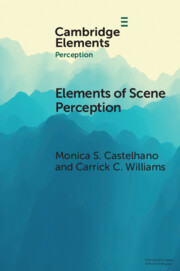Refine search
Actions for selected content:
34 results
Eye-tracking and economic theories of choice under risk
-
- Journal:
- Journal of the Economic Science Association / Volume 5 / Issue 1 / August 2019
- Published online by Cambridge University Press:
- 17 January 2025, pp. 26-37
-
- Article
- Export citation
Global and Local Covert Visual Attention: Evidence From A Bayesian Hidden Markov Model
-
- Journal:
- Psychometrika / Volume 68 / Issue 4 / December 2003
- Published online by Cambridge University Press:
- 01 January 2025, pp. 519-541
-
- Article
- Export citation
Local vs. Global Covert Visual Attention: Are Two States Necessary? Comment on Liechty et al., 2003
-
- Journal:
- Psychometrika / Volume 68 / Issue 4 / December 2003
- Published online by Cambridge University Press:
- 01 January 2025, pp. 543-549
-
- Article
- Export citation
Bilingual toddlers show increased attention capture by static faces compared to monolinguals
-
- Journal:
- Bilingualism: Language and Cognition / Volume 26 / Issue 4 / August 2023
- Published online by Cambridge University Press:
- 20 January 2023, pp. 835-844
-
- Article
-
- You have access
- Open access
- HTML
- Export citation
Biasing simple choices by manipulating relative visual attention
-
- Journal:
- Judgment and Decision Making / Volume 3 / Issue 5 / June 2008
- Published online by Cambridge University Press:
- 01 January 2023, pp. 396-403
-
- Article
-
- You have access
- Open access
- HTML
- Export citation
Word order preference in sign influences speech in hearing bimodal bilinguals but not vice versa: Evidence from behavior and eye-gaze
-
- Journal:
- Bilingualism: Language and Cognition / Volume 26 / Issue 1 / January 2023
- Published online by Cambridge University Press:
- 20 May 2022, pp. 48-61
-
- Article
-
- You have access
- Open access
- HTML
- Export citation

Elements of Scene Perception
-
- Published online:
- 06 October 2021
- Print publication:
- 11 November 2021
-
- Element
- Export citation
Social orienting is reduced in williams syndrome
-
- Journal:
- European Psychiatry / Volume 64 / Issue S1 / April 2021
- Published online by Cambridge University Press:
- 13 August 2021, pp. S124-S125
-
- Article
-
- You have access
- Open access
- Export citation

The Breadth of Visual Attention
-
- Published online:
- 25 May 2020
- Print publication:
- 18 June 2020
-
- Element
- Export citation
Development of attention from birth to 5 months in infants at risk for autism spectrum disorder
-
- Journal:
- Development and Psychopathology / Volume 32 / Issue 2 / May 2020
- Published online by Cambridge University Press:
- 23 April 2019, pp. 491-501
-
- Article
- Export citation
Visual attention in adults with attention-deficit/hyperactivity disorder before and after stimulant treatment
-
- Journal:
- Psychological Medicine / Volume 49 / Issue 15 / November 2019
- Published online by Cambridge University Press:
- 18 December 2018, pp. 2617-2625
-
- Article
- Export citation
Age-Related Changes in the Allocation of Vertical Attention
-
- Journal:
- Journal of the International Neuropsychological Society / Volume 24 / Issue 10 / November 2018
- Published online by Cambridge University Press:
- 31 August 2018, pp. 1121-1124
-
- Article
- Export citation
A perceptually grounded model of the singular–plural distinction
-
- Journal:
- Language and Cognition / Volume 6 / Issue 3 / September 2014
- Published online by Cambridge University Press:
- 13 May 2014, pp. 327-369
-
- Article
- Export citation
Talking about quantities in space: Vague quantifiers, context and similarity
-
- Journal:
- Language and Cognition / Volume 2 / Issue 2 / June 2010
- Published online by Cambridge University Press:
- 11 March 2014, pp. 221-241
-
- Article
- Export citation
Grammatical aspect influences motion event perception: findings from a cross- linguistic non-verbal recognition task*
-
- Journal:
- Language and Cognition / Volume 6 / Issue 1 / March 2014
- Published online by Cambridge University Press:
- 29 January 2014, pp. 45-78
-
- Article
- Export citation
Behavioural effects of directive cues on front-of-package nutrition information: the combination matters!
-
- Journal:
- Public Health Nutrition / Volume 17 / Issue 9 / September 2014
- Published online by Cambridge University Press:
- 16 August 2013, pp. 2115-2121
-
- Article
-
- You have access
- HTML
- Export citation
Psychometric Properties of a Test for ADHD Based on Binocular Rivalry
-
- Journal:
- The Spanish Journal of Psychology / Volume 16 / 2013
- Published online by Cambridge University Press:
- 07 June 2013, E20
-
- Article
- Export citation
16 - Executivefunction
- from Section I - Structural and Functional Neuroanatomy
-
-
- Book:
- Behavioral Neurology & Neuropsychiatry
- Published online:
- 05 February 2013
- Print publication:
- 24 January 2013, pp 225-249
-
- Chapter
- Export citation
Functional specialization in the lower and upper visual fields in humans: Its ecological origins and neurophysiological implications
-
- Journal:
- Behavioral and Brain Sciences / Volume 13 / Issue 3 / September 1990
- Published online by Cambridge University Press:
- 19 May 2011, pp. 519-542
-
- Article
- Export citation
Right hemisphere infarct patients and healthy controls: Evaluation of starting points in cancellation tasks
-
- Journal:
- Journal of the International Neuropsychological Society / Volume 16 / Issue 5 / September 2010
- Published online by Cambridge University Press:
- 13 July 2010, pp. 902-909
-
- Article
- Export citation
